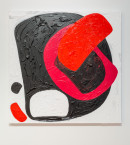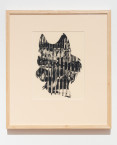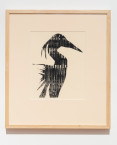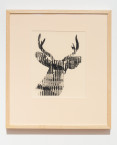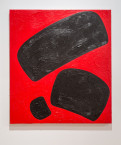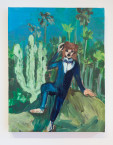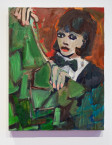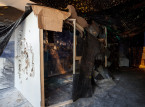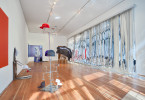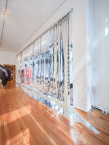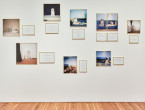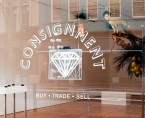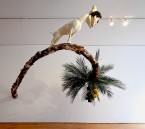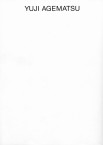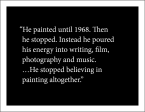Artspeak
Kim Nguyen
A curator and writer based in San Francisco, where she is Curator and Head of Programs at the CCA Wattis Institute. Nguyen was formerly Director/Curator of Artspeak from 2011-2016. Her writing has appeared in exhibition catalogues and periodicals nationally and internationally, with recent texts in catalogues published by Pied-à-Terre (San Francisco), Gluck 50/Mousse (Milan), and the Herning Museum of Art (Denmark). Nguyen is the recipient of the 2015 Hnatyshyn Foundation Award for Emerging Curators in Contemporary Canadian Art and the 2016 Joan Lowndes Award from the Canada Council for the Arts for excellence in critical and curatorial writing.
Exhibitions
-
JASON HIRATA, GARRY NEILL KENNEDY, LAURA OWENS
February 19–March 19, 2016 -
ABBAS AKHAVAN
November 21–January 16, 2016“After all, the point of art is to show people that life is worth living by showing that it isn’t.”—Fanny Howe, Bewilderment
We have no doubt that art has the capacity to assume a pedagogical role, one that can be stretched and bent to fit into endless tributaries of thought. More nebulous, however, is its position within emotional labour, as its effectiveness is measured through a viewer’s subjectivity. Emphasizing the emotional intelligence of these objects is not a disservice to its historic, academic, or political significance. We have much to learn from these things, but at the fore is that they are a lesson in empathy. There is no immediate recovery from the deep well of loss that comes from acknowledging the intimate and everyday forms of violence that dehumanize our existence. There is only process, and within that, finding words for what is beyond language.
The materialization of not-making—as in all the activities that surround or are instrumental to artistic production, but not production itself—is a business of false vacancies. There is no absence in not-making. It is filled with banal but consuming activities such as paying bills, doing laundry, napping, working for pay, more sleeping. But not-making is also bodies—from the hidden labour that supports our privilege, to the ecological and individual survivors of cultural and topographical ruin, to the generative and collaborative friendships that are the foundation of our social relations.[1] Artistic creation and political action are derived from similar spaces, and the boundaries of life and work for Abbas are elliptical. He is, much like his work, equal parts generosity and sorrow. And his work, much like he, is a willful rejection of making for not-making.
What can be determined from the curtains, the sheaths of dying palms, the precarious towers of dishes that have formed his lineage of not-making? They trace invisible lines of exclusion, of impermanence, of colonialism, of loneliness. Endangerment and invasiveness appear, again and again. As does our unease. To better navigate, we rely on facts. In this room alone, two hundred and twenty-seven kilograms of plants cast in bronze, dispersed amongst these white bed sheets. The sheets are remnants of not-making, used to wrap the plants during transport. This is an incomplete archive of the artwork, but also of the plants themselves, which originate from species endemic and native to the region around the Tigris and Euphrates rivers. Conflict has ravaged these banks, from the destruction of the salt marshes by Saddam Hussein’s Ba’athist government to the scars of the Iraq war. The heaviness of this not-making leaves no space for apathy, a response so often engendered by geographic distance.
The scale is misleading and powerful. A thistle becomes a head, imperfect branches become scorched arms, and our well of loss is no fuller. It is humbling to be amongst these things, as caretaker, as friend. There is so much to be learned. During the time we have known each other, Abbas has taught me a great deal, about vulnerability and the integrity of not-making. About the importance of leaving.[2] And for this, I am fortunate.
To begin and end with Howe: “The politics of bewilderment belongs only to those who have little or no access to an audience or a government. It involves circling the facts, seeing the problem from varying directions, showing the weaknesses from the bottom up, the conspiracies, the lies, the plans, the false rhetoric; the politics of bewilderment runs against myth, or fixing, binding, and defending. It’s a politics devoted to the little and the weak; it is grassroots in that it imitates the way grass bends and springs back when it is stepped on. It won’t go away but will continue asking irritating questions to which it knows all the answers.”
NOTES
1 Of the many things that one can learn from the indomitable Jeanne Randolph it is that “long-term loyalties and tenderness are what preserve an art scene from functioning like a corporation.”
2 You don’t have to go home but you can’t stay here.
Abbas would like to acknowledge the support of the Royal Botanic Gardens at Kew, the Royal Botanic Garden Edinburgh, and in particular Dr. Sophie Neale and Shahina Ghazanfar, Canada Council for the Arts, and the Ontario Arts Council. Special thanks to Georgina Jackson, The Abraaj Group, and The Third Line.
-
LISA RADON
September 12–October 31, 2015Another possibility?—the experimental feminine shaping history conceived not as fateful adumbration, but as dynamic coastline where past and present meet in the transformative rim of our recombinatory poesis. … Experiments in every discipline are born out of the unanswered questions, the unfulfilled improbabilities of the past, but also out of the radically unintelligible nature of the contemporary.
Joan RetallackThe mathematics itself suggest a movement in which everything, in which any particular element of space may have a field which unfolds into the whole and the whole enfolds into it. So you have this movement, and I call this the implicate or enfolded order which unfolds into the explicate order where everything is separate. Now [in] the implicate order, everything is internally related to everything. Everything contains everything. David Bohm
“The lever that has fallen through a crack in time.” This is how retired construction worker Wallace “Wally” Wallington describes his “logo” on his website, theforgottentechnology.com, which is an animated gif he means to illuminate “how the ancient wonders [pyramids, &c] were constructed.”
With common materials—2x4s, buckets of concrete, scraps of lumber—Wallington constructs simple machines—the beam levers, counterweights, twin pivots, and shims—to transport and raise enormous blocks of concrete comparable in scale to the megaliths at Stonehenge. He documents his researches on a DVD for sale ($17.95/free shipping) on his website.
The word concrete is derived from the Latin concrētus, past participle of concrēscĕre to grow together.
Stonehenge, specifically the great trilithon, the encompassing horseshoe arrangement of the five central trilithons, the heel stone, and the embanked avenue, are aligned to the sunset of the winter solstice and the opposing sunrise of the summer solstice. Construction was begun on the earliest circular bank and ditch enclosure around 3100 BCE; the last construction or modification took place around 1600 BCE. One wonders how long it took for the forgetting, for the Neolithic astronomical machine to become a mystery. William Stukeley’s 1720 drawing of the site, identifying its axis aligning with summer solstice sunrise, was a revelation in its time. Two hundred and forty years later, Gerald Hawkins used the Harvard-Smithsonian IBM computer to analyze 165 significant features of the site, checking every alignment between them against every rising and setting point for the sun, moon, planets, and bright stars in the positions they would have been in 1500 BCE. He found dozens.
The matter of alignment. The alignment of matter. Machines and tools. And what we forgot.
Consider the square bracket and its functions. Brackets as a tool to insert comment, explication, or correction into. Bracketing off as setting aside some subset for the moment to focus on a specific aspect of the whole. Bracketing off as sidelining such that recovery is in order. The square bracket embracing the ellipsis is the void. But also, it is related to the rhizomatic promise of the bibliography, digitized. This is the wormhole and the romance. See also: brackets as protectors. [“Shields up.”] Two little hands cradling the between. The subtext of soft brackets or parentheses as a whisper and a promise. Little moons. The square bracket as a butch version of the crone. As coastline. As standing stone. As sentinel.
Traces of water in the rock, traces of rock in the water.
Foraminifera (Latin, hole bearers) are a phylum (or class) of amoeboid marine protozoa (of over 10,000 species both living and fossilized), characterized by reticulating pseudopodia, with streaming granular ectoplasm and a minute perforated test or shell comprising one or more chambers. The tests of these rhizopodous forams, constructed of calcium carbonate or agglutinated sediment particles, are quite baroque, various, and arresting in form. Tiny holey stars, bone pillows, the tests accumulate to form thick calcareous deposits on the ocean floor that fossilize to form the basis of chalk or limestone.
Sediment, the settling, the trace of this moment, is soon buried by more sediment, and disappears.
Humans have only fairly recently become good at communicating with future humans; thus forgettings and subsequent mysteries.
Consider the tree throw, that hollow left behind when a great tree blows over, roots and all. The mineral-rich soil revealed. Consider that which accumulates there—rain, leaves, fur, scat—and what this accumulation facilitates, not the least of which is a welcoming moment for the decomposers, the end and beginning of things.
“Are you an electrician?”
“In a manner of speaking.”It is a knot, this, which is to say a tangle pulled tight. Or rather it is a knot of knots of loops of lines, this array of autonomous objects. As a knot, it could be plucked apart, loop by loop, given care and time and patience. The question at hand is whether it is more interesting to pluck its lines apart and lay them straight or to allow oneself to idly run one’s fingertips over its labyrinth.
Touch matters.
Matter matters: white oak, live oak, achillea millefolium, rosmarinus officinalis, and incidences of the Monterey Formation, which is to say calcareous, phosphatic, and siliceous fine-grained sedimentary rocks.
Circumstances matter, stances round the outer edge. Begun, for example, under the new moon, again, again, this was completed under the second full moon in August. The entire enterprise was preceded and grounded in a dance around a center on Mt. Tamalpais, the mountain called “the right eye of the world.” Circumstances? Breath. So much touching. The waters. The sun on skin. Passiflora, cistus, and the accidental fermentation. The yearling compost that amended the bed for the rose geraniums and the failed gourd. The heron and the return of the hawk children. The thinnest threads of white stone. The improvised hair loom. Arms coated in blond sawdust, gypsum dust blanketing everything. The taste of gypsum.
Objects accumulate. They keep secrets. They do works.
On August 13 the European Space Agency’s Rosetta spacecraft documented Comet 67P/Churyumov–Gerasimenko passing through perihelion. As 67P approached the sun the increasing solar radiation heated up the nucleus causing its frozen ices to escape as gas. These gases and the dust particles that they drag along create 67P’s coma or atmosphere and tail. What we see of the comet is evidence of its coming undone.
Postscript 64: Cindy Mochizuki on Lisa Radon
-
CHARLENE VICKERS
August 1–August 31, 2015Protection can be provided through preservation, through space, through care, through time, through consideration, through empathy, through criticality, through solemnity, through affection, through sharing, through progress, through strength, through language, through departures, through sorrow, through accumulation, through provocation, through presence, through repair, through loss, through scrutiny, through material, through discomfort, through shape, through melancholy, through invasion, through expectation, through kinship, through revulsion, through complicity, through mystery, through discourse, through artefact, through overestimation, through recklessness, through pause, through contradiction, through rhythm, through contact, through retraction, through uncertainty, through insistence, through vulnerability, through arrangements, through exchange, through hands and heads, through disclosure, through lapses, through privacy, through consciousness, through conscience, through and again.
These cedar spears were part of a larger healing installation for missing Aboriginal women called Ominjimendaan, the Anishinabe word meaning to remember. Inspired by the natural defence armour of the porcupine and its quills, the hand-carved spears symbolize a large-scale form of protection for Aboriginal women who live with the realities and trauma of systemic colonial racial violence.
These masks were collected by Vickers’ father, David Vickers. David passed away in 2014. Having grown up with these masks and now living with them every day as part of her own home, Vickers acknowledges how influential their presence has been on her life and art practice. “These masks have medicine.” Traditionally used by the False Face Medicine Society of the Haudenosaunee, they bear within them cultural history and personal significance as powerful objects that carry healing. Exhibiting them in this context, Vickers is making an offering of protection and healing for those who have experienced loss and trauma. There are too many. The False Face Masks interspersed with the carved spear quills construct an environment of healing, the objects becoming Vickers’ offerings of Tobacco or Asemaa.
Through the sun, into the set.
As Anishinabe Kwe/Ojibway Woman, Vickers formally respects and recognizes Haudenosaunee traditions and thanks the carver of these masks, Grey Flying Cloud, Miigwetch.
-
ERICA STOCKING
June 6–July 18, 2015Bear with me here, I am going to make an argument for the middle. Not as a space of mediocrity or stunted progression or where disappointment transitions into bitterness. But the other middle, the insides, the guts, the glue. If the things worth remembering are the highs and the lows, what about the middle that binds it altogether? We are in a moment in which beginnings seem naive and endings are too often depicted as tragic or apocalyptic. Maybe we got it all wrong, the middle is where the good stuff is, where the real things happen but also where real things are dismissed as banal and inconsequential. Where do the things worth forgetting go to grow old?
*
The original source material of these sculptures is a collection of video recorded moments, real things that occurred in the life of Erica Stocking and her family over the span of six months. The highs and the lows are present—birthdays and dinner parties and tears—but the compilation is mostly comprised of the middle, daily activities routinely left behind. The shapes and sounds that constitute her narrative morph in film, as they do in life and in memory. Stocking lifts patterns and forms that appear throughout, constructing a vocabulary for the collection from the architecture of her house, to her children’s artwork, to the most obvious reference of clothing. In previous work she has created new use value out of discarded materials from her home, and in a similar fashion this collection salvages moments potentially destined to disappear.
*
“There are so many bodies that request me to be a body. A confused body in the sense that it is a mirror body, a reflective body. A body of the surroundings. How do I be that body but let it be guided by the inner one and the inner conversation?” The presence of bodies (the other other middle) is implied in the structure of the clothes themselves—a stiff bend in a sleeve or underwear resistant to collapse. We define ourselves amongst the bodies around us. They carry the weight of our memories, they construct our lives. But these bodies are moving, each on their own timeline and trajectory. What happens when one body leaves or if not enough stay? When one is lost? When no one that remembers your childhood is left? Do you cease to exist? Or do you exist, but less? You begin to wonder how many things in the world are not discrete, things that are in fact defined by missing bodies, like parked cars and vacant benches.
*It is uncertain what happens to bodies in the subtraction of time. Does the body become a vessel for memory? There is no intention of nostalgia in these clothes, nor should they (or bodies) be confused as props. They are not stand-ins or players tasked with telling a specific story. They are a ground to experience nothingness.[1] They are real things that elicit jamais vu, operating in the neighbourhood of our actual experiences and memories but are completely unfamiliar. The intimate life of someone else is not ours to take, and here we are given real things that are replicas of replicas. What connects the real things, the insides, the guts, the glue, cannot be accessed. We grasp at strands of recognition, mining our pasts or our current lives that never feel private enough. We are reminded of a time when beginnings were not yet naive and when failure felt distant, when unrealistic expectations could still take root. When fingers could be extensions of toes.
*
We are not time, we inhabit it. Living in the middle is a very explicit habitation of time, so much so that we barely mark its passing. We are losing time all around us. But the might of insignificance is almost calming. It means we do not need to find what has been forgotten. It means choosing to participate in the living, the middle, the now.
*
These objects remember for her but it is possible she is remembering for us.
NOTE
1 “Is not the experience of the thing and of the world precisely the ground that we need in order to think nothingness in any way whatever? Is not thinking the thing against the ground of nothingness a double error, with regard to the thing and with regard to nothingness, and by silhouetting it against nothingness, do we not completely denature the thing?” – Maurice Merleau-Ponty
The artist gratefully acknowledges the support of the BC Arts Council.
-
INVERNOMUTO
March 21–May 2, 2015In short, this is a story of fathers. A father of Ethiopia, a father of reggae and dub, fathers of the Rastafarian movement, a socialist father who bred a future fascist father who became the disgraced father of a nation. Fathers have so many accoutrements. History is unspooling at the ankles of sons. It is uncertain if any of this is worth repeating. To tell this story of fathers they will need to construct a new alphabet, they decide. This alphabet will be composed of symbols and gestures, people and sounds, bound together through ritual. The articulation of this alphabet requires them to ask how we can be released from history, and through what means. The answer is that we cannot. More must be uncovered, as it is apparent that the atrocities of colonialism cannot be healed through one story, one father, or one form. It is a frightening reality for the children of both victims and oppressors. Invernomuto are two sons who are not brothers raised in the Italian village of Vernasca.
The origins of the Negus project are biographical and historical, beginning with an event that took place during the Italian Fascist period. In 1936, a wounded soldier returns to Vernasca from Abyssinia (the former Empire of Ethiopia, as it was referred to in Europe). In celebration of his homecoming, the community organized a festive but ultimately disturbing ritual in which an effigy of the last Negus of Ethiopia, Haile Selassie I, was burned in the main piazza. The absence of photographic or film documentation meant this obscure event lived only in oral history, told to these two sons through first hand accounts by family members who attended the ceremony. Perhaps the most sinister aspect of this event was how it persisted in the local dialect—the term “Negus” had come to refer to an individual who was ridiculous, ostentatious, unkempt, and clumsy. Two sons who lived apart both grew up hearing this word, only learning of its actual provenance in adulthood.
As Selassie was considered a messianic figure for the Rastafarian movement—which formed in Jamaica after his coronation in 1930—the two sons determined that the appropriate spiritual guide for this story would be another father, the dub and reggae legend Lee “Scratch” Perry. Perry does not live in the past, riding streams of consciousness beyond the stretch of his ring-covered fingers. He is as devout to Rastafarianism as he is to mysterious cosmological forces, establishing a universe of sounds, symbols, and attitudes that operate according to his internal logic. A father who hears divine voices is someone who can invoke the ghost of Selassie, the two sons are certain. This will be a ritual to purify Vernasca from its sins. History is in their bones, but they can only remember so much. They need to disrupt the bass line of memory, actual over invented, one version on top of another, old rhythms over new ones. Decades later, through the bellows of this father, they witness the third world burning down in Vernasca.
Negus exhales and retracts, accruing new references in each presentation as it climbs further into the recesses of Italian colonialist history. Two prominent icons, the gloved Mickey Mouse hand and the signature star logo of Mercedes-Benz, are essential to the Negus lexicon, one representing the mobilization of popular culture and youth for propagandistic purposes, the latter a reminder of colonialism’s entanglement with capitalism. During the Fascist era, a crude and racist song about Mickey Mouse circulated throughout the country, depicting the character traveling to Abyssinia to murder “the Moors,” a derogatory term referring to medieval Muslims.[1] The three-pointed star, intended to represent Mercedes-Benz’s domination of land, sea, and air, was rumoured to be initially associated with Selassie and later stolen by the car company. In repayment, Mercedes-Benz provided Ethiopia with free trucks and engines for public transportation, an act that robbed a country of the ownership of a cultural symbol while reminding them of their subjugated position through capital might.
Although these are reminders of our mistrust in history they also act as offerings of apology—efforts by two sons to acknowledge the transgressions of one father to another, through another. Light rises across the windows, over images of Ruatoria, New Zealand, the easternmost point in the world and the first place to be illuminated by sunlight. A dissident Rasta Maori community, described as a “terrorist sect” by a New Zealand journalist, resides in Ruatoria, awaiting the coming of the Messiah, Haile Selassie I. And so we also wait, with these two sons, for history to unspool, and for elephants and lions and men. Standing on the hills, watching the world, burn round and round.
NOTE
1 “All Mickey Mouse films are founded on the motif of leaving home in order to learn what fear is.” Walter Benjamin, Mickey Mouse, 1931 -
VALÉRIE BLASS
January 24–March 7, 2015It begins in 1992, but perhaps more seriously in 1995. Blass, and her work, represent the elongation of recognition. She devotes her twenties to doing what most people do in their twenties, finding her way, and in 1995 she enrolls in fine arts at the Université du Québec à Montréal. Hers is a career that feels antithetical to the rapid pace of contemporary art but is a path far too familiar for women. She is approaching thirty when she decides to be serious about art making, and even then prolongs the completion of her graduate studies. She has responsibilities to her children and to herself to earn a living. She sees her male peers rise to success in half the time. But she does not need to be in the business of catching up, which erroneously implies she is behind. She is, and this is fortunate for us, an artist out of time.
It should be noted that in 1992 Canada sends its first woman into space.
Describing anyone as a magician feels absurd.But it would not be misguided to refer to Blass as such. Her five years in film set design made her adept at artifice, and she is an expert in misdirection and sleight of hand. Her work reminds us that our sense of perception is easily punctured. The colour you thought was yellow is actually blue, the slumped figure that you understood as your mother is in fact your father (or worse, yourself). Her process generates estrangement, with our own bodies and with the things that surround us (whose limbs are these?). There are parts that feel common place and uneasy—poses from classical sculpture and their patriarchal origins, or the hand wielding a knife that protrudes from a lumped object, who exists somewhere between abstraction and figuration. Slipping in and out of fiction, the work is anachronistic and, ultimately, odd. Its peculiar qualities stem from Blass’ singular vision, which is not afraid to be awkward or vulgar, or, perhaps more dangerously, female.
Misdirection is apparent in her interest in puppets. In a puppet show viewers are intended to look at the puppets and not the puppeteers (whose limbs are these?), even though it is their collaborative movement that produces a performance. Similarly, in the museum, sculptures are staged by positioning the parts (artifacts) with the assistance of a support system. We are asked to imagine the missing pieces and reconstruct the original sculpture, but the system itself participates in the museum experience. “When viewing one of the murals face on, we see emerging an image, a situation, an action. And when we circulate the links in between things become mechanical, machine-like. The portrait of a woman, sculpted from head to thigh, which we see from behind…This is the image, but in reality the mirror enlarges, her face is cut, a tiny bas-relief fixed right where her face should be. What makes sense when we look frontally deconstructs itself when we look from the side. The possibilities are endless.”
The front is not enough. The sides offer a disassembled story, a tangle of ropes, mirrors, keys, and signs that materialize narrative links. An arrangement of elements on the wall from a distance formulate a face, with eyes and lips protruding at clumsy intervals. Blass plays with anamorphosis and distortion, mirror effects and flattened objects. No angle is to be trusted as posture and form give way to the limits of materials. In the same way our lives require dimension, these fronts are not enough. Experiments with life stories, written in a language of icons and caricatures, of simple pictures, of films or surrealist photos. A stereotypical sculpture for a stereotypical story, an overlap of false autobiographies. “My life: my summer of drugs. My marriage. My childhood. The spring I had three lovers.” Whose limbs are these?
The artist would like to thank the Conseil des arts et des lettres du Québec and The Canada Council for the Arts.
-
MATT BROWNING, JORDY HAMILTON, GYUN HUR
November 22–January 10, 2015THOSE WHO HAVE NOTHING HAVE ONLY THEIR DISCIPLINE. —Alain Badiou
He has just graduated from his masters degree in fine arts. The opening for his graduate exhibition is overwhelming. He is relieved the darkest two years of his life have come to an end and he is preparing for the bone crushing depression to set in. He invites his family. His parents come, but his mother has a broken leg and his father inexplicably is wearing a button that confirms he once played our national sport as a child. He was pretty good at it, but no one cares now because he barely makes a living doing what he educated himself to do, nevermind what he did for mandatory recreation. His family is the most boisterous of the bunch, the variety that spills red wine on concrete floors. The conservator looks on, upset. A professor accuses him of setting up this scenario for laughs.
She is about to do her first international artist talk. This city feels big and exciting, maybe even new. This is terrifying. She is a working class kid from somewhere other than here. That alone means she has a seven-year handicap in this town. Everyone around her feels so sophisticated, so shiny. None of this matters, she says to herself. She is a working class kid from somewhere. Her steel belt is a badge of dishonour in some circles but it girds her for disappointment. How did she end up in this position, in this business of making? Silk dust is rubbed on her knees and under her fingernails. Loss lives in this dust, built by a community of hands over three, four, five months. She has her father’s hands but hers are covered in modern day soot, or papercuts and coffee grounds.
Yellow Cedar is native to the Pacific Coast of North America. It’s admired for its durability, fine grain and warm, uniform colour. It lives in our oars and our poles, the floors of his house and the boat he never uses. But it is a fraud, a cypress masquerading as a cedar. Someone once told her there was no room for sincerity in contemporary art. He argues that it is not a question of whether there is or is not sincerity in contemporary art, but that art is broken and we have no business grounding our sincerities in it. He’s looking to have it both ways, to assume both the practice and the aesthetic of work and labour. He wants to be both critical and complicit. There is contradiction in these corners. Although each appears to be a faithful reproduction of the one previous, imperfections from his two hands linger. They are mechanical, repetitive, devoid of narrative, but not free of sentiment. It’s a cypress as a cedar but at least it is resistant to decay.
In their repetition, in their banality, these paintings feel familiar. Non-offensive, normative forms repeatedly carved by his grandfather in his own work. He thinks the image came from a popular woodworking magazine. It feels good, making these. Versions of this image are littered across the country, he is certain. He worries about this notion of living with intention. Does that just mean making something with your own two hands? Has “your own two hands” become a synonym for condescension, classicism, and patriarchy? Is this obsession with craft creating an idealized and inaccurate portrait of ourselves? What becomes of us, when we pander to this conservative agrarian fantasy of making? He wonders if this network of images, littered across the country, are linking a community of underpaid and unpaid hands. He panics that what he makes should express the cultural and economic conditions of its making. His father called him an artiste, once.
-
YUJI AGEMATSU
September 13–October 25, 2014CARETAKERS
I
Waste in the city is like an ocean, a perpetual tide of narratives and references that overlap and bleed into one another. Things that are swept into corners and guided under soles. Things that find themselves in collections, of an amateur, informal variety, such as the undiscerning landfill, or through more discriminating eyes, to be taken home for their sheen or how they lay against one another. There are things that give, things that take. Things the economy forgot, or things that peculiarize time. It’s always high tide in New York City.
II
Yuji Agematsu does not remember. He does not want to. Since 1980, he has moved in and out of streets, like a dance, collecting things. Some refer to it as trash. Maybe they are gifts. Or orphans. Or something akin to a shadow, waiting to be whole. His movement across the city is without structure; he walks where he pleases and does not want to consider where he belongs, where he came from, or his own identity in the process. A form of liberation through aimless walking, after the work day, when composition ends and improvisation begins. Through chance, he encounters pieces of plastic and coils of hair, chunks of rock salt and brittle bird bones, newspaper mâchéd through rain and dirt. They are taken, and kept, as found. The tenuousness of these things is not a concern. Impermanence is almost desirable, a recognition that what falls into hands, artistic or otherwise, eventually disappears.
III
To collect is to believe in mystery. To subscribe to the idea that meaning stubbornly resides in things even after its apparent use value expires into waste. The moss is talking again. “They are looking at me always,” he says. “I am just a slave to the duty, passion, and convention of them. I will have to take care of them. If I do well it guarantees my slave’s freedom.”
IV
By the time you are 58 years old you will have devoted nearly 1770 hours of your life to brushing your teeth.
V
Each day he creates a work in a cellophane sleeve slipped off a packet of cigarettes. Items are dropped inside the pouch, the composition defined without his influence. Their “completion” is determined intuitively, with these feral materials continuing to change shape, shift chemical states and crumble at the edges. Nothing stays the same, but why should it? Expectations for stasis are always met with disappointment. His is a habit that supports an addiction, and an addiction that structures a habit—the number of sleeves is determined by the amount of cigarettes he decides to smoke that day (that week, that month), while the search for the bodega to retrieve more cigarettes, or the seven minutes outside to smoke, places him in the hands of more material.
VI
Findings are pinned to tables and walls, forming intricate patterns that reference his experimental music training. Compositions are improvised, and scattered between is an uneven procession of cigarette butts and chewing gum, perhaps two of the most common currencies in trash. Things that change dramatically, rendered unrecognizable by time and rot, rest alongside materials that persist, such as strips of tape and foil whose man-made resilience underline the contradiction in these arrangements. Although it is a collection that rejects nostalgia—a belly in constant digest—the emotional aura of the materials linger. The affixed objects bob up and down in height but nothing is privileged over the other in their treatment. He does not seek out anything specific and there is no discovery more special than the previous. “I notice myself as a human being when I happen to meet them,” he says.
VII
These compositions are not telling us secrets we do not already know, and there are no lessons to be learned. The dust settles. He makes it his business to watch, to observe, to create time capsules that make no allusions for forever. The collection wilts—it is added to but never grows. It falls apart, pools and evaporates, and is consumed by the living, creatures who thrive on decay. Finding things breeds fatigue, as is want for things that are never met. Wage increases that never come, laundry that needs to be washed, a box of cigarettes that need to be replenished.
VIII
What responsibility does he carry for this infinite waste? The vast ocean, a tangible void, gathers things and binds us together. “Sides and bottom, of which the jug consists and by which it stands, are not really what does the holding. But if the holding is done by the jug’s void, then the potter who forms sides and bottom on his wheel does not, strictly speaking, make the jug. He only shapes the clay. No—he shapes the void. For it, in it, and out of it, he forms the clay into the form. From start to finish the potter takes hold of the impalpable void and brings it forth as the container in the shape of a containing vessel. The vessel’s thingness does not lie at all in the material of which it consists, but in the void that holds.” [1]
IX
He grows tired but he has to take care of them. He does his best.
NOTE
1 Martin Heidegger, “The Thing”
This project is generously supported by the BC Arts Council. Thanks to Yale Union, Judd Foundation, Real Fine Arts, and Skylight Gallery.
-
NATASHA MCHARDY
August 1–August 31, 2014Ongoing installation in Artspeak’s windows while the gallery and office are closed for summer holidays.
It’s morning. It’s hot outside. The sun is bright and full, lobbed in the sky, one after the other, after the other, until the heat turns to flames. A salon of heads. An ominous, long eared creature stares blankly nearby. The door is locked. A message is being relayed. Should we turn around? How do we escape? We must keep on. This path feels familiar. It is well-tread, but the ease of this tread is unsettling. We walk a bit further, we walk by again. We do not belong here. You refuse to turn around. Opportunity and desire surround us. These are dangerous feelings. We keep on.
Our hands graze across the forms, sliding animal to the left and waves of water to the right. We are lost. Out of the pool and through the window. How do we get to the other side? Falling out of step, we are seduced by the brightness, the tropical colours and leafy limbs that remind you of a locale long ago. You believe it is yours, you desire it to be so. Snowy peaks rest in their place, in the distance, their jagged slopes softened by the haze of day. Reaching for the sun, judged by a thousand sons, one after the other. Escape and entrapment. The door is locked.
Cool down. Feel the heat against your face as you emerge from the pool. The palms are a brief reprieve. We grow tired, our legs having lost the tread. We slip further into the pyramid of stars. The door is locked. Tomorrow we try again.
-
AJAY KURIAN
April 12–May 24, 2014AJAY KURIAN:
Do you think that I’m attempting to trace any ghosts?
KIM NGUYEN:
I don’t know if you are tracing the ghost or if you are collecting, relocating, and generating them. The ghost always exists somewhere in between but is never the original, and I think you are not particularly interested in accuracy even if your work has elements of precision. It’s not about following the ghosts to a specific end point or in a predetermined manner but rather making the path less finite or elongated.
AK:
Art often feels much more like an encounter of some kind than a thing–an encounter that can unfold a series of divergent paths, an encounter with a thing that never has as good of a name as the encounter itself.
KN:
Do we really want art to be the encounter though?
AK:
The encounter is something that exists whether we want it to or not. Some days the painting in my bedroom is art. Other days it is decor and stuff on the wall. Some days the Pollock at the Met is art. Other days it is an oversized print that I’ve seen in too many clichés. The tradition of much of art from the 20th century is to make us avid and inquisitive in how we address the world around us. Much of it came from out of daily life, asking and sometimes imploring us to look again. Sometimes for beauty, sometimes for savagery, oftentimes a cocktail of the two and many other ingredients. In a way, art kept training us to see differently, to begin to diagnose the world on our own, without its help. After seeing so many Aaron Siskind photographs as a kid, I certainly didn’t look at the marks on the walls the same way. But after I noticed the marks on the walls, Aaron Siskind wasn’t really that compelling anymore. I realized early that art was not eternal, it was something that mattered sometimes and not in a linear way. I suppose this is what I mean by the encounter. Some encounters don’t go away, but some do—some come back. Either way, cultural periods allow for different encounters and what that means.
KN:
I initially interpreted your definition of encounter in a different way, but I think we actually agree, or that we have arrived at the same destination through different paths. It helps to hear your exposition. I also believe that these definitions are shifting, contingent on time, circumstance and context, and that this fluidity of time, memory, and perception is a bit of a trained exercise. I do not consider art to be eternal and actually have grown so incredibly weary of “legacy” in the past few years for similar reasons. Your perspective is perhaps less cynical than mine. To clarify my initial reaction: let’s say I see a billowing curtain in a window. At some point in my life maybe I think it’s beautiful and poetic in that American Beauty bag in the wind sort of way. And then tomorrow I think it’s just a curtain. And maybe I like that it’s just a curtain, and that there isn’t much more to it, and that’s okay. I have such a sensitivity to the colonialist nature of art that maybe I just want certain things in my life to not be defined by it, to somehow exist in parallel but not be in service of. Sometimes I so painfully want a curtain to just be a curtain because if it’s anything more, I may not have much left to give.
AK:
I have a bottle in my studio that has layers of painting medium encrusted within it like layered, golden skins. Every time I’d use it (when I used to paint) it would crust over and I’d have to bust its surface to get more out. So you can see all that history in this bottle. It’s a beautiful object, but I never want it to be art…
I named the title of this show “Tapetum Lucidum.” Why do you think that is?
KN:
I think the title references an abstract understanding of time but also a tension between senses and the ability to see the infinite. Perhaps somewhere in these reflections of light lies the myth of salvation.
AK:
I wonder what the myth of salvation means today…
On another track, I might bring your attention to this as well:
Maybe these are the clouds of salvation?
KN:
The darkest part of that video for me was how they made a very close mold of the man’s head and then proceeded to erase his face entirely in order to make the mask. Both this mask and Sabbath’s song are like a sad reverse Medusa. Are these replicas and surrogates some form of uchronic dream?
There is also a funny uncanny moment in which Letterman is smoking the e-cig and I realize that he’s allowed to do it because we have no rules about televising the smoking of nicotine water vapour (or when Katherine Heigl stumbled over whether or not she could say she inhaled). It’s okay because we all believe in the artifice? Is it depressing that we no longer see (or desire to see?) beyond the myth?
AK:
I didn’t know what uchronic meant so I searched for it on Google and was really fascinated by its definition: not a completely fictional time, but one that is maybe an alternative, a hypothetical, still related to our reality but still not ours. Its provenance is also rather interesting.
KN:
It is indeed. I think I initially encountered it with regards to reenactments, particularly historical reenactors and their desire to participate in these activities. It was sort of questioning whether they reenacted events because they were not personally involved but feel that they can somehow change history (or memories), or write themselves into it, to generate some sort of alternate (but equally real) history.
AK:
I curated a show in St. Louis at White Flag Projects about 4 years ago and they have a library upstairs and I thought of creating various plaques for the library: Historical Fiction, Science Fiction, Religious Fiction, Utility Fiction, Platonic Fiction, Bastard Fiction…the list could go on almost endlessly.
KN:
Platonic Fiction is really just the best, I love that.
AK:
Thanks Kim.
Postscript 57: Steffanie Ling on Tapetum Lucidum (PDF)
-
CAROLINE MONNET, DEVIN TROY STROTHER, LAWRENCE PAUL YUXWELUPTUN
February 8–March 29, 2014Barn Swallows brings together three artists whose works combine the vocabulary of popular and traditional visual-cultures with the tropes of modernist abstraction to create unique hybrids forms. Each artist uses this strategy for a different purpose, as the basis for formalist exploration, to consider representation’s role in the political tensions of modernity, or to reflect on the power dynamics at play in the portrayal of race and gender in art history and popular culture.
Lawrence Paul Yuxweluptun’s recent ovoid paintings and sculptures complement his more familiar figurative tableaux of the past thirty years. While the idealized Northwest-Coast formline shapes are freed from their traditional depictive role, the titles nonetheless root these works in the artist’s broader concern with representation, the landscape and First Nations political struggles.
By contrast, Caroline Monnet’s Anomalia collage and silkscreen series approaches abstraction by splicing together found images of urban development, resource extraction and Hollywood depictions of First Nations culture, dissolving the originals into a fragmentary field of overlapping facets. These fields are, in turn, cropped into the shapes of silhouettes of animal and human figures—each image in the series offering a different view on the collision of nature and culture in recent history.
Devin Troy Strother’s high-relief assemblages and paintings centre around caricatures of black figures in sometimes gory, sexualized scenes on top of abstract backgrounds, which poke fun at the pretensions of formalism. Sardonic titles like A Black Joan Jonas in “Nigga I’m a Coyote” highlight the entangled histories of primitivism and abstraction within avant-garde art, asking, in the process, who has the right to use certain kinds of language and certain kinds of history.
-
BECKY KOLSRUD, KALUP LINZY, ELIZABETH MILTON
November 16–January 18, 2014Opening: November 16, 8pm
Based on the telenovela, Back to the Door takes its title from a common soap opera trope—where a character is speaking ill of another, and the subject of their derision is standing in the door behind them. Unlike its counterpart, the soap opera, the telenovela is a fictional serial with a predetermined duration, depicting both the development and conclusion of a central plotline. Subjects range from romance to comedy, the supernatural to the erotic, to murder mysteries, all with a heavy integration of melodrama. Originating in Latin America in the 1950s, the telenovela has played a role in the construction of nationhood and collective identity, acting as a platform for individuals from varying backgrounds to engage with social and political issues while generating a shared public space and vernacular across geographic, class, and social divides.
The works in Back to the Door reference the complexities of melodrama, camp, and stereotypical portrayals of gender, weaving together issues of class and identity with emotional rigour and self-reflexivity. For her portraits of anonymous women, Los Angeles-based Becky Kolsrud draws from her collection of found photographs of sorority girls, school portraits, and glamour shots. Her subjects range from historical re-enactors to stand-up comedians and athletes, and Kolsrud creates awkwardness through composite poses and unusual settings. The works emphasize the body language, clothing, and gaze of her source material, extending these representations of women beyond the decades from which they originate.
In his telephone-conversation-based soap opera, Conversations Wit de Churen (2002-present), Kalup Linzy (New York) constructs an irreverent narrative of sex, family, and violence, performed by the artist and a cast of friends, routinely dressed in drag. Inspired by the soap operas of his youth, Linzy replaces the predominantly Caucasian, upper class, and heterosexual characters with individuals representative of his own upbringing in the rural American South, employing a lo-fi aesthetic and regional dialect to create an ironic and humourous complication of race, class, and gender. Presented in the exhibition is the third installment of the series, Da Young and Da Mess (2005), in which the lead character is consulting a telephone psychic about a marriage proposal.
For Cotton Candy Insulation Keeps You Warm and Cuts Like Glass (2013), Elizabeth Milton (Vancouver) will work with a procession of participants—including soap opera fanatics, drag queens, and magicians—to destroy prop-glass (traditionally made with sugar in the theatre and movie industry) in a series of private performances. Toying with gestures and actions pulled from various performance referents (including Hollywood film, musicals, opera, and punk rock), the performances will take place after hours in the closed gallery, with the accumulated residue of the events altering the installation. The work will culminate in a video presented the last week of the show. As a critical examination of gender roles and the boundaries between comedy, tragedy, and emotional authenticity, Milton aims to articulate the cultural lust for spectacular “breakdown” and the commodification of psychic rupture.
-
ABIGAIL DEVILLE
September 14–October 26, 2013Abigail Deville’s work is comprised of archaeological constructs imbued with cultural and historical cues, referencing canonical sculptures from recent art history, contemporary social issues, and the movement of solar bodies. Her dark sculptural installations are steeped in destruction and decay, acting as reflections on social and cultural oppression, racial identity, and discrimination within the ruinous decadence of the big city. For her exhibition at Artspeak, DeVille will create a new site-specific installation comprised of materials she scavenges from the streets of Vancouver, particularly in the gallery’s neighbourhood of Gastown in the Downtown Eastside. Her past work has employed a similar strategy of sourcing materials, using cardboard, broken furniture, bottles and other discarded objects. Her complex vortexes generate a dialogue about the socioeconomics of cities and the displacement of its inhabitants, and her exhibition will directly reference the alleyways and streets of Vancouver.
-
MICHELLE BLADE, SHANNON BOOL, HEATHER GOODCHILD, MORGAN WATT
June 29–July 27, 2013Premised on the concept of thanatophobia, the works in Sunbeams have been brought together for their shared interest in the undetermined. Although defined as a fear of death or dying, the origin of thanatophobia can also be an apprehension or aversion to the unknown. The inability to comprehend what occurs after death can be a source of anxiety for individuals, and those most prone to this specific type of phobia are often highly intelligent and inquisitive, or those who question their own philosophical or religious beliefs. In addition to ritual and spirituality, the works in the exhibition maintain an engagement with craft and labour, adopting lengthy production processes to address a contemporary Western relationship to faith, the afterlife, and end times.
In 366 Days of the Apocalypse (2012), Michelle Blade (Los Angeles) created paintings for an entire year, the impetus for the series being the myths surrounding the 2012 Mayan prophecies. Produced daily, the project created a ritual in which the artist moved towards both the literal end of the work and the proposed end of the world. Elements of romanticism, ritual, and existentialism are present in the work, as Blade conceals her surfaces with ominous hazes and subsumes her figures into transcendent landscapes. Despite its foreboding premise, the work is not intended to act as a warning, but rather an examination of our relationships to rituals, prophecies, and our own sense of mortality.
Everyday life, literature, psychology, and art history are frequently referenced in Shannon Bool’s (Berlin) work, which takes a range of forms including wall paintings, photograms, collage, and sculpture. Casino Runner (Aztec Inn) (2011) is a twenty-foot-long carpet whose pattern is derived from a wall-to-wall floor covering of an Aztec-themed casino from the 1980s. The casino itself is homage to a relic of American Art Deco, the Aztec Hotel, which continues to operate in Monrovia, California. The hotel exemplifies American Art Deco’s appropriation of the geometric patterns and symbols of ancient Mexican civilizations, and Casino Runner complicates this cross-cultural relationship. Hand-woven by traditional village weavers in Anatolia, Turkey, the carpet alludes to the delirious and sublime experience of entering a casino while simultaneously creating an Eastern interpretation of a Western sensibility.
Since 2009, Heather Goodchild (Toronto) has focused her work on Anna Ward Brouse, an imagined character in a secret society conceived by the artist. Brouse is an amalgamation of several 19th century North American spiritual leaders, and within this constructed narrative Goodchild develops systems, regalia and rituals of Brouse’s visions, using this process to locate meaning within her own desire for spirituality and ritual in a culture lacking religion. In Journey Portrait (2009) and Journey Landscape (2009), Goodchild draws from the rituals and symbolism of Freemasonry, Girl Guides, and childhood games, gathering inspiration from the works of mythologist Joseph Campbell and Alchemical practices. Within a system of symbols and proverbs, the individual rugs outline voyages towards personal fulfillment achieved through sacrifice.
Word play and language figure prominently in the work of Morgan Watt (New York), who arrived at embroidery through his interest in the process of drawing and contemplative, labour intensive practices. Investigating the intersection of drawing and embroidery, Watt became intrigued with medieval tapestries, and his work references methods of communications in the medieval era, in particular battle standards. Works such as Primitive Understanding (2013) relay envisioned conversations amidst the fear and chaos of the battleground. Although the absurdity and humour of these interactions is apparent in the dialogue, anxieties of death and fear are prevalent in the works, with falling arrows alluding to the prospect of death arriving in a violent or abrupt way.
-
ALEX DA CORTE
May 4–June 15, 2013In Bacon Brest, Alex Da Corte (Philadelphia) reconsiders the system of Hollywood through a revised version of “Six Degrees of Kevin Bacon”—a parlor game which proposes that anyone on earth is a mere six connections from the actor. Da Corte repositions players such as Martin Brest, Wes Craven, and Halle Berry’s Catwoman as central bloodlines of Hollywood, weaving through their varying careers to investigate the inconsistencies of Hollywood itself. Puncturing holes in its immaculate veneer, the artist posits that the structure of Hollywood is both faulty and essentially human, and the absorption of success and failure should instead be considered requisites for ingenuity and innovation beyond the cinema.
Da Corte creates sculptures out of repurposed materials collected from retail stores and various locales in his travels. He identifies his process as a form of cultural anthropology, utilizing modest, found materials that point to our intimate relationship with discardable items, asking us what these consumer objects reveal about our recent past and what direction we are headed. Toying with ideas of taste, Da Corte proposes that failure is in fact an essential component of risk and rule breaking; and the celebration and acknowledgment of flaws in a milieu that scorns and dismisses imperfection can resuscitate a vernacular from moments previous. His sculptures maintain traces of their past lives, reviving lost narratives while exposing the capacity of mass-produced objects to be surrogates for power, sex and happiness.
-
When Someone Strange Is Calling You Home
ALEJANDRO CESARCO, TOSHIE TAKEUCHI, ALLISON TWEEDIE
March 16–April 20, 2013A companion to As Far As I Can See (November 17, 2012-January 12, 2013), which looked at the metaphorical and physical space of running away, this three-person exhibition focuses on the theme of returning home. Works expressing relief, claustrophobia, absurd domesticity, and the end of a journey will be presented. Of particular interest are works that address the unknown within the familiar. Included in the exhibition are a photographic and film installation about the emotional relationship between humans and dogs by Toshie Takeuchi (Netherlands); a series of home and garden collages by Allison Tweedie (Vancouver); and an optimistic wall drawing by Alejandro Cesarco (New York).
Toshie Takeuchi investigates the naïveté and sensitivity of human relationships through surreal narratives that are based on theoretical research, her own memories and experiences, as well as those of people she interviews for her work. Tampopo Head and the Name of the Dogs (2011) is based on the lives of two reclusive men—Ed, a quiet philosophy lover, and Hilko, who lives with six female dogs named after real life women. The work is inspired by an unsettling incident in which Hilko named one of his two dogs after Takeuchi, and Ed named the other after his own daughter. The fairytale-like film explores the melancholic tendency of people to project their emotions onto dogs, investigating relationships between neighbours, daughter and father, a man and a woman, a man and his dog, and between namesakes. The narrative is guided by Japanese voiceovers by Takeuchi, which are paired with the other characters’ English monologue. This layering of languages contributes to the peculiar and poetic relationships portrayed in the film. By questioning the psychological intent behind the act of naming, the work highlights the ambiguity between identity and reality.
Referencing popular culture, art history, and literature, Alejandro Cesarco’s conceptual practice is focused on the autonomy of text and the relationships between work and spectator, the written word and the reader. His work, which takes the form of photographs, films, collages, installations, and artist books, often integrates autobiographical as well as literary references. Past work has addressed cliché in relation to strategies of seduction and romantic archetypes, looking at how the prevalence of cliché continues to influence and form our desires and our memories of them. Presented in the exhibition is Here Comes the Sun, a wall drawing from 2004 that plays with abstraction and emotional perception with a restrained economy of means. The painted strip of yellow along the bottom of the gallery wall references the end of one day and the beginning of another, inciting both relief and a feeling of loss.
Allison Tweedie’s collages often feature duplication and repetition—of identical images, formal elements and recurring methodical gestures—to collapse the meaning of the image. The source material for many of her collages is an American instructional book series on gardening and lawn maintenance from the 1960s and 1970s. Tweedie reconstructs the manicured landscapes and benign domesticity of the original images into surreal scenarios and double visions. The shifts, inclusions, and juxtapositions are slight—sufficient enough to elicit a sense of unease, but in an indeterminate manner. In several of the works, figures are depicted being overtaken by slow encroaching foliage. The banality of this gesture is disconcerting, and in their strangeness, the works convey a future created in the past.
Postscript 51: Jacqueline W. Turner on When Someone Strange Is Calling You Home (PDF)
-
EMMELINE DE MOOIJ, MICHAEL DUMONTIER, ANDREA HELLER, MINA TOTINO, UNTIL WE HAVE A HELICOPTER, DANIEL G. WONG
November 17–January 12, 2013Bringing together six international and Canadian artists, As Far as I Can See contemplates a theme of running away from home. The exhibition investigates the metaphorical space of running away—the lost, explorers and wanderers, and meandering thoughts and dreams—and the physical act of escape—traversing other worlds, ghostly creatures, the dark forest, and the unknown. The exhibition presents both a voyage provoked by the imagination and the beacon that brings us home.
Among the works included is Cloud Studies by Mina Totino (Vancouver), an ongoing series of Polaroid photographs of clouds taken since 1997. Marked with a date, time and occasional anecdotes, the Polaroids reference both the idle pursuit of cloud watching and the transcendent nature of the sky. As a sobering counterpart to Totino’s clouds, Michael Dumontier (Winnipeg) presents a series of foil-stamped books in which the sky is grounded by uniformity and repetition. While no photograph is alike in Cloud Studies, Dumontier presents a scenario in which the intangible sky suddenly feels defined and decisive.
In her 2011 work Hello Trouble, Emmeline de Mooij (Amsterdam) subtly points to the dark and foreboding aspect of fleeing. Composed of plastic, burlap, mud and fabric, the work insinuates a welcoming of the ominous, underlining the possibility that despite the potential for danger, running away breaks us from the confines of the ordinary. The desire to explore the uncharted extends to Daniel G. Wong’s (Lethbridge) work, Are You Wild Are You Free (2012). Wong’s practice is an exploration of wonder, mystery, and poetry in everyday living. He embarks on adventures to immediate and faraway surroundings, wandering to encounter the mundane and remarkable. Wong produces meditations on his findings, questions, and discoveries in the form of zines, posters, and blogs, and his work in this exhibition is generated from recent excursions in Iceland.
Inspired by the memories of her childhood, Andrea Heller (Paris/Zurich) creates a sombre universe populated by creatures and shadows. The playful aura in her work is juxtaposed with suggestions of gloom and abyss. Heller’s work examines the forest as hiding place, incorporating elements of mischief, cheerfulness, and humour. This excursion to the edge of the woods is met with Beacon For The Moonshined Wanderer (2009) by Vancouver-based collective Until We Have A Helicopter, a work comprised of a collection of antique lanterns suspended by rope. The work hangs from the window of the gallery, acting as the destination and departure point for those that stray and the ones that return.
Postscript 49: Sheryda Warrener on As Far As I Can See (PDF)
-
DANH VO
September 8–October 27, 201220 janvier 1861.
J.M.JTrès cher, très honoré et bien-aimé Père,
Puisque ma sentence se fait encore attendre, je veux vous addresser un nouvel adieu, qui sera probablement le dernier. Les jours de ma prison s’écoulent paisiblement. Tous ceux qui m’entourent m’honorent, un bon nombre m’aiment. Depuis le grand mandarin jusqu’au dernier soldat, tous regrettent que la loi du royaume me condamne à la mort. Je n’ai point eu à endurer de tortures, comme beaucoup de mes frères. Un léger coup de sabre séparera ma tête, comme une fleur printanière que le Maître du jardin cueille pour son plaisir. Nous sommes tous des fleurs plantées sur cette terre que Dieu cueille en son temps, un peu plus tôt, un peu plus tard. Autre est la rose empourprée, autre le lys virginal, autre l’humble violette. Tâchons tous de plaire, selon le parfum ou l’éclat qui nous sont donnés, au souverain Seigneur et Maître.
Je vous souhaite, cher Père, une longue, paisible et vertueuse vieillesse. Portez doucement la croix de cette vie, à la suite de Jésus, jusqu’au calvaire d’un heureux trépas. Père et fils se reverront au paradis. Moi, petit éphémère, je m’en vais le premier. Adieu.
Votre très dévoué et respectueux fils.
J. Théophane Vénard
m.s. -
AARON FLINT JAMISON
June 9–July 21, 2012Opening Friday, June 8, 8PM
This project is made possible with special support from the BC Arts Council Innovations Program.
-
The Weight of Lives I’m Not Living
GUY BEN-NER, FABIOLA CARRANZA, NAUFUS RAMIREZ-FIGUEROA
March 31–May 12, 2012This exhibition brings together the work of three artists who investigate how art can be at the service of life, raising ethical questions of where the distinguishing line is between art-making and personal and professional relations. Referencing language, tropicalism, and informal economies, the works examine the intimacy of familial relationships while constructing narratives on personal and geographic displacement. Included in the exhibition are video by Israeli artist Guy Ben-Ner (Tel Aviv); a large-scale sculpture by Naufus Ramirez-Figueroa (Vancouver/Guatemala City); and a pop-up jewellery consignment shop by Fabiola Carranza (Vancouver/Costa Rica).
Beginning in the early nineties, Guy Ben-Ner has produced a series of videos starring himself and his family, occasionally using the intimate spaces of their home as a makeshift set or, in his well known work Stealing Beauty (2007), having a domestic drama unfold in the showrooms at IKEA. With his children grown into adolescence and his divorce finalized, Ben-Ner’s more recent work expresses a life of wandering and the loss of a sense of belonging. Drop the Monkey (2009) expounds the difficulties of starting a new relationship and was made shot-by-shot in camera without external editing during twenty-five trips between Tel Aviv and Berlin over the course of a year. Shot in Hebrew and dubbed in English, Drop the Monkey presents a conversation in rhyme while overtly questioning the divide between art and personal relations. A screening of his works Second Nature (2008) and Wild Boy (2004) will take place on May 5th.
Two recurring concerns in Fabiola Carranza’s practice are the investigation of language and appropriation as an aesthetic strategy. Her work often focuses on the historical and cultural specificities of her source materials, exploring the tensions between privilege and impoverishment and between her adopted home of Vancouver and her home country of Costa Rica. For this exhibition, Carranza has constructed a modest consignment shop in the gallery to sell used wedding rings. The rings—remnants of relationships whose reasons for dissolution are not disclosed—are available for purchase for the duration of the exhibition.
The son of a former guerrilla fighter in the Guatemalan Civil War, Ramirez-Figueroa’s work delves into political violence, his experience as a refugee in Canada, and his personal difficulties with being a descendant of wealthy landowners. Despite the serious subject matter, his works are often tinged with absurdity and humour. In Bitch on a Bent Palm Tree (2011), Ramirez-Figueroa presents a horizontal tree with a dog perched on the trunk. The dog bears the face of Lynndie England, the former American soldier who was convicted in 2005 for her participation in the abuse and torture of prisoners at Abu Ghraib prison in Baghdad. The work pairs ideas of excess as they relate to empathy, while simultaneously acknowledging the tropics as a trope—a place of leisure, sex, luscious fruit, and endless natural resources.
Postscript 46:Jenni Pace on The Weight of Lives I’m Not Living (PDF)
-
I had a great trip despite a brutal feeling of cognitive dissonance
SAMUEL ROY-BOIS
February 4–March 17, 2012OBJECTS REMAIN SPELLBOUND IN THE MERCIFUL SEPARATION OF SPACE, NO MATERIAL PART CAN COMMONLY SHARE ITS SPACE WITH ANOTHER, AND A REAL UNITY OF DIVERSE ELEMENTS DOES NOT EXIST IN SPACE.
—Georg SimmelTHE FORM OF A CITY CHANGES, ALAS, MORE RAPIDLY THAN A MAN’S HEART.
—BaudelaireArtspeak is pleased to present I had a great trip despite a brutal feeling of cognitive dissonance, a new solo exhibition by Vancouver-based artist Samuel Roy-Bois. Reconfiguring and partitioning the gallery, the exhibition demonstrates the artist’s continued interest in the deconstruction of space. An enclosed living area—inhabited by a stranger free of charge for the duration of the exhibition—will be made private with no public access, its occupant given full authority over its usage. Paired with the built environment is a voice recording that furthers the gallery’s transformation into an intimate place of residence.
Through concealment, the installation portrays a character with a double identity—the individual that we hear and try to visualize and the one that we will never see and may occasionally hear. By juxtaposing the viewer and the occupant’s respective experiences, Roy-Bois creates an uncanny moment in which they imagine each other, creating a new imagined reality. In addition to bringing forward notions of estrangement, space retribution, and struggles for power, the exhibition contributes to an ongoing discussion in Vancouver about how land in the city is divided, occupied, and used.
-
DIVYA MEHRA
November 26–January 28, 2012Divya Mehra’s practice draws from experiences of displacement, cultural conventions, and hybridization, infusing a biting wit in the execution of her projects. Connecting political and religious icons with popular hip-hop culture, Mehra examines cross-cultural appropriations and the parallels between family tension and nationalistic conflict. Her work investigates the construction and misrepresentation of cultural identity while making reference to layered divisions and the disparity and exploitation of power. Engaging with decay, excess, and failed celebration, Mehra will present an exhibition comprised of new sculptural and photographic work and a performance by a local gospel choir.
-
TRICIA MIDDLETON
August 1–August 31, 2011Ongoing installation in Artspeak’s windows while the gallery and office are closed for August.
Comprised of various sculptural works, Work Friends addresses issues of value, modes of display, and the instability of material relations. The installation includes six awkward, oddly shaped plinths that in their non-uniformity are reminiscent of forms that range from anthropomorphized figures to haunting cityscapes. Built from the misshapen and broken brick remnants of Middleton’s 2009 exhibition Dark Souls (Musee d’art contemporain, Montreal), the plinths create unlikely and uneven arrangements that radically transform from day to night.
Accompanying the plinths are peculiar objects of consumption and labour—empty cans, bottles, and cups, alongside a wood-handled mop, and metal bucket—suggesting recent use by a fleeting presence, now departed. The scene recalls the forms and aesthetics of a not so distant past, but conjures this effect through lightweight, contemporary materials that are deliberately concealed to give the appearance of age and decrepitude. As the installation moves from day to evening, what can be considered a humble mimicry of gallery accoutrements in the daytime becomes far more menacing and ghoulish with each passing hour, as Middleton manipulates coloured lights to dramatically transition the space into night. Through the combination of these objects, Middleton asks whether something more exists in the power of the material, something akin to self-determination.
Talks & Events
-
JASON HIRATA, GARRY NEILL KENNEDY
March 12, 2016Jason Hirata and Garry Neill Kennedy will speak about their work in the exhibition Adminstrate, on view at Artspeak until March 19, 2016.
-
HOLIDAY NAIL BAR
December 10–December 11, 2015Artspeak is turning The Fox Cabaret and The Block into holiday nail bars!
Nail designs by:
Susanna Browne
Kelly Lycan
Erdem TaşdelenManicures $35 or free for members
Thursday, December 10th
6-9pm
The Projection Room
The Fox Cabaret
2321 Main Street
Hosted by Liza Lewis
Music by Darwin Meyers
No CoverFriday, December 11th
5-8pm
Champagne Friday at The Block
350 West Cordova StreetSponsored by The Fox Cabaret, The Block, and Butter London.
-
ABBAS AKHAVAN, KELLY LYCAN
November 21, 2015Kelly Lycan responds to Abbas Akhavan’s exhibition, on view at Artspeak until January 16, 2016.
-
ZIP: 01–01–14…12–31–14 Book Launch
YUJI AGEMATSU
October 28, 2015Artspeak, Yale Union, and Thea Westreich Wagner and Ethan Wagner present:
ZIP: 01–01–14…12–31–14
Book Release
Wednesday, October 28, 6–8pm
114 Greene Street, 2nd Floor
New York, NY 10002With a limited edition by Yuji Agematsu, and special performance by L. GRAY (a project by Keith Connolly) at 7:30pm
-
LISA RADON
October 17, 2015Please join us on Saturday, October 17, at 2pm for a reading by Lisa Radon as part of her exhibition, [ ], which runs until October 31.
-
ERICA STOCKING, ELIZABETH ZVONAR
June 20, 2015Artists Erica Stocking and Elizabeth Zvonar will discuss Stocking’s solo exhibition at Artspeak, 2pm.
-
Shopping Cart Pantheism Book Launch
JEANNE RANDOLPH
May 16, 2015Artspeak will also launch Out of Psychoanalysis: Ficto-Criticism 2005-2015 at this event.
-
HAVE YOU HEARD THE ONE ABOUT THE COW, THE FRENCHMAN, AND THE BOTTLE OF BUDWEISER?
ANTHONY HUBERMAN
April 8, 2015Some thoughts about wall texts, press releases, exhibition brochures, catalogues, and other modes of address—aka: how an art institution expresses itself.
-
INVERNOMUTO
March 21–March 21, 2015Cineworks
300-1131 Howe St (entrance in back lane)In partnership with Cineworks, Artspeak presents a talk and screening by Italian artist duo, Invernomuto.
Invernomuto is the collaboration of Simone Bertuzzi and Simone Trabucchi, who work with moving-image and sound, blending popular rituals and symbols from folklore and urban culture.
In conjunction with their exhibition at Artspeak, which opens on Friday March 20th at 8.00pm and runs until May 2nd, Invernomuto will present selected screen-works in the context of conversation about their practice and the role of expanded documentary within it.
Working primarily with moving-image and sound, blending popular rituals and symbols from folklore and urban culture, the duo explores the collapse and subsequent mixture of languages. Presented at Artspeak will be an instalment of their ambitious Negus project, initiated in 2011. The project is an expanded documentary that mixes various languages, ranging from classic documentary to esoteric fictional mise-en-scène. Negus is based on an historical event dating back to the Italian occupation of Ethiopia and traces an imaginary line linking their hometown of Vernasca, Italy, to Ethiopia and Jamaica. The work amalgamates historical fact, cultural ghosts, and past political scenes with music and performance rites of obscure traditional origins. Simone Bertuzzi (b. 1983) and Simone Trabucchi (b.1982) have been collaborating as Invernomuto since 2003. Although they primarily work in moving image and sound, Invernomuto also integrate sculpture, publishing, and performance in their practice.
-
VALÉRIE BLASS, ARIANE NOËL DE TILLY
January 24, 2015Artspeak is pleased to present a conversation between Valèrie Blass and Ariane Noël de Tilly in conjunction with the exhibition, Valèrie Blass: My Life, on view at Artspeak from January 24 – March 7, 2015.
-
MATT BROWNING, JORDY HAMILTON
December 13, 2014Please join us for a conversation between Matt Browning and Jordy Hamilton, presented in conjunction with the exhibition, Seurat and Friends, on view at Artspeak from November 22, 2014–January 10, 2015.
-
YUJI AGEMATSU
September 13, 2014163 East Pender, 3rd floor
8pmAgematsu will perform a new piece as part of his exhibition at Artspeak. Space is limited, no admission after 8:15pm.
-
MARCIA BELLUCE, TEDDY CUI, FRANÇOIS DION, SUE DONALDSON, WENDY FROST, DIANA LEUNG, CHERRYL MASTERS, RICH NEWIRTH, MARNIE RICE
August 1–August 31, 2014Please enjoy these summer reading “picks” from Marcia Belluce, Teddy Cui, François Dion, Sue Donaldson, Wendy Frost, Diana Leung, Cherryl Masters, Rich Newirth, and Marnie Rice.
The PDF is available here.
-
AJAY KURIAN
April 12, 2014Artist Ajay Kurian will discuss his solo exhibition Tapetum Lucidum at Artspeak.
-
TANIA WILLARD
March 1, 2014Artist and curator Tania Willard will deliver a talk in response to Artspeak’s current exhibition Barn Swallows.
-
ELIZABETH MILTON
January 11, 2014Artist Elizabeth Milton will discuss her work in the exhibition Back To The Door at Artspeak. The talk will include a screening of the film component of Cotton Candy Insulation Keeps You Warm and Cuts Like Glass (2014), produced over the duration of the exhibition.
-
ABIGAIL DEVILLE
September 14, 2013Artist Abigail DeVille will discuss her exhibition Gastown Follies at Artspeak.
-
SHANNON BOOL, JEN CURRIN, MICHAEL DUMONTIER, ANTHONY HUBERMAN, BRIAN KENNON, TOSHIE TAKEUCHI
August 1–August 31, 2013Please enjoy these summer reading “picks” from a selection of local and international artists and writers, including Shannon Bool, Jen Currin, Michael Dumontier, Anthony Huberman, Brian Kennon and Toshie Takeuchi.
The PDF is available here.
-
Talk: Death—The Great Motivator in Medieval Art
CAROL KNICELY
July 13, 2013In conjunction with the current exhibition Sunbeams, Carol Knicely will present a related talk: Death—The Great Motivator in Medieval Art.
-
SEAN ALWARD, SYDNEY HERMANT
May 11, 2013Speakeasy: Salon is a series of talks and presentations that interrogates Artspeak’s mandate to encourage a dialogue between visual art and writing. In this incarnation, speakers will present within the conversational salon format on wide-ranging subjects including art, music, literature, politics, popular culture, and science. Speakers select their own topics for discussion and are not expected to be experts in the subjects they present. Each session ends with a conversation between participants and speakers, creating an opportunity for the exchange of ideas and critical discourse, and a mutual scholarship of the topics explored. Speakeasy: Salon references both the demand for interdisciplinary learning in contemporary art and writing practices and an interest in the informal academic institution.
SEAN ALWARD
Figures in Landscapes: Lion-People and Hermaphrodites (an archeology travelogue and slide-show)
From the caves of Baden-Wurttemburg to the coast of British Columbia: the world’s oldest portable sculpture, the world’s oldest musical instrument, lion-people, mammoth slivers, live German cavemen, Einstein’s basement, sea-life turned to stone, compressed tropical substance, petroglyphs, and hermaphrodites.
SYDNEY HERMANT
Getting to Know You: What My 4 and 7/8 yr old Daughter Taught Me About Textiles
-
ALEX DA CORTE
May 4, 2013Artist Alex Da Corte will discuss his exhibition Bacon Brest at Artspeak.
-
GRANT ARNOLD, ROBIN SIMPSON
April 13, 2013Speakeasy: Salon is a series of talks and presentations that interrogates Artspeak’s mandate to encourage a dialogue between visual art and writing. In this incarnation, speakers will present within the conversational salon format on wide-ranging subjects including art, music, literature, politics, popular culture, and science. Speakers select their own topics for discussion and are not expected to be experts in the subjects they present. Each session ends with a conversation between participants and speakers, creating an opportunity for the exchange of ideas and critical discourse, and a mutual scholarship of the topics explored. Speakeasy: Salon references both the demand for interdisciplinary learning in contemporary art and writing practices and an interest in the informal academic institution.
GRANT ARNOLD: The Lord of Obstacles in the Suburbs: My Carved Ivory Figure of Ganesh
ROBIN SIMPSON:
“I had just contracted an upper respiratory infection when Kim asked me to participate in this series. The infection was working its way between my sinuses and bronchial passage. I refused to rest my voice and within a week I had lost it completely. That was about a month ago, my voice has returned but I continue to run into people who have the same infection. Most of these people are in some way or another connected to artist-run culture here in Vancouver. Something is going around. It´s caught at openings and talks, the handful of bars we frequent, from popular library books, and the other speakeasies and studio parties we attend. I´ve been daydreaming of a new mute art scene or at least one where we all spoke in hushed, guttural voices.Previous installments of this series have taken place under assigned topics. This time around things are a little more casual. Last fall many of us participated in a conference that assessed the state of artist-run culture. There is another on-going para-academic series in town, happening not far from here with university professionals who speak on their area of expertise. Here we’re making room for marginal research, the off-cuts, hobbies, fancies, preoccupations, and early propositions. This is intended to be a salon, not a clinic. Save the diagnosis for another address.
If we can’t or refuse to decide on a shared topic maybe we can change the way we speak. I’ll present a number of strategies and examples in voice modification. Some of these are easier and more accessible than others. Special invitation is extended to those who have caught that ambulating throat infection.”
-
CATE RIMMER, JEN WEIH
March 23, 2013Speakeasy: Salon is a series of talks and presentations that interrogates Artspeak’s mandate to encourage a dialogue between visual art and writing. In this incarnation, speakers will present within the conversational salon format on wide-ranging subjects including art, music, literature, politics, popular culture, and science. Speakers select their own topics for discussion and are not expected to be experts in the subjects they present. Each session ends with a conversation between participants and speakers, creating an opportunity for the exchange of ideas and critical discourse, and a mutual scholarship of the topics explored. Speakeasy: Salon references both the demand for interdisciplinary learning in contemporary art and writing practices and an interest in the informal academic institution.
JEN WEIH: YOU TELL THE OCEAN IT DOESN’T KNOW
“I am going to talk about the sprawling set of interests I have related to the fact that the sun is moving really really really fast. It has its own orbit of the galaxy. The image of the sun floating quietly in space with the planets moving around it in circles was true for a time, but is now a fiction of convenience. Likely topics include- the Copernican revolution, the ego, the site of art, Agniezka Kurant, maybe Stephen Kaltenbach, the infinite, probably Borges on Xeno, and hopefully dancing.”
CATE RIMMER: A SAILOR’S PORNOGRAPHIC KEEPSAKE
A consideration of a historical “marital aid” and related maritime erotica.
-
TOSHIE TAKEUCHI, CINDY MOCHIZUKI
March 16, 2013Artspeak is pleased to present a conversation between Toshie Takeuchi (Netherlands) and Cindy Mochizuki (Vancouver) in conjunction with the exhibition, When Someone Strange is Calling You Home, on view at Artspeak from March 16-April 20, 2013.
-
MINA TOTINO
December 1, 2012Artist Mina Totino will discuss her work in the exhibition As Far As I Can See at Artspeak.
-
GABI NGCOBO
October 10, 2012Independent curator, educator, and artist Gabi Ngcobo (South Africa) will respond to Danh Vo’s exhibition One Beauty Sleep Away at Artspeak. This event is presented in conjunction with Institutions by Artists, a three-day international event that evaluates and activates the performance and promise of contemporary artist-run centres and initiatives.
-
Out of Psychoanalysis Book Launch
JEANNE RANDOLPH
September 22, 2012A talk/reading in conjunction with the launch of Jeanne Randolph’s Artspeak publication, Out of Psychoanalysis: Ficto-Criticism 2005 to 2011.
Out of Psychoanalysis is a collection of essays and ficto-criticism from Winnipeg-based cultural critic Jeanne Randolph. Composed between 2005-2011, the texts include psychoanalytic responses to contemporary art exhibitions, a collection of vignettes, lamentations on capitalism, and a contrived history of Canadian ficto-criticism. The books address a diverse range of subjects including the Cucumber Mosaic virus, Bob Dylan, Sigmund Freud, insects at the bottom of a river in Winnipeg, and the colour blue.
-
CLINT BURNHAM, RANDY LEE CUTLER, OMER FAST, AARON FLINT JAMISON, TRICIA MIDDLETON, PHILIP MONK, PAMELA ROSENKRANZ, KLAUS SCHERUÜBEL
August 1–August 31, 2012Please enjoy these summer reading “picks” from a selection of local and international artists and writers, including Clint Burnham, Randy Lee Cutler, Omer Fast, Aaron Flint Jamison, Tricia Middleton, Philip Monk, Pamela Rosenkranz and Klaus Scherübel.
The PDF is available here.
-
AARON FLINT JAMISON
July 14, 2012at Pacific Bindery
870 West Kent Ave
Vancouver, BCPlease join us at Pacific Bindery with the artist Aaron Flint Jamison. This event is presented in conjunction with Jamison’s exhibition that is on view at Artspeak until July 21st.
This event is co-presented with Western Front.
This project is made possible with special support from the BC Arts Council Innovations program.
-
GUY BEN-NER
May 5, 2012A screening of Second Nature (2008) and Wild Boy (2004) by Guy Ben-Ner, presented in conjunction with the exhibition The Weight of Lives I’m Not Living.
-
FABIOLA CARRANZA, NAUFUS RAMIREZ-FIGUEROA, MAGNOLIA PAUKER
April 28, 2012Fabiola Carranza and Naufus Ramirez-Figueroa in conversation with Magnolia Pauker, in conjunction with the Canadian Art Gallery Hop, Vancouver. Presented as part of the exhibition The Weight of Lives I’m Not Living.
-
LISA MARSHALL
April 1–October 31, 2012Artspeak is pleased to inaugurate a new writing residency program beginning with Vancouver writer Lisa Marshall. The residency is both an opportunity to foster local writing practices and a chance to reflect on Artspeak’s activities. Encouraging unique strategies on writing, the program assists Artspeak in our efforts to create meaningful opportunities for discussion, research, and collaboration. Marshall will be in residence for a seven-month term from April-October 2012, building upon her skills in critical art writing, editing, and publishing while furthering her growth in contemporary writing practice.
Project Description: Textuality
One of Michael Fried’s main concerns about Minimal art in 1967 was that it “can be formulated in words.” Shortly after, Seth Siegelaub pointed to a condition that was already in play: we most often encounter art through textual representation as description or as idea. Conceptual practices turned to language as a primary form, thus rendering the object in the gallery secondary. In response to this pivotal point, Textuality is a research and writing project investigating the longstanding relationship between art and text with its roots in the textual turn of the late 1960s. Questions related to these conditions will be considered with a particular focus on Vancouver. What have been the repressed conditions of art’s relationship with text? How has text been incorporated into the field of art and to what effect? What is the core area of expertise for writing about art now? These questions and others will be explored through interviews, analysis of texts, and consideration of artists’ projects.
-
SAMUEL ROY-BOIS
February 25, 2012World Art Centre , 2nd Floor
SFU Woodwards, 149 West Hastings Street
4PMArtspeak is pleased to present a talk by Vancouver-based artist Samuel Roy-Bois, presented in conjunction with his solo exhibition, I had a great trip despite a brutal feeling of cognitive dissonance.
-
ARTSPEAK 25
February 11, 2012Artspeak 25th Anniversary Celebration
Old Faithful Shop, 320 West Cordova Street
7PM
$100 ticket includes Friend level membership and admission for you and a guest. FREE for current members at the Friend level. Membership can be purchased here.
Please join us on Saturday, February 11, 2012 at 7PM in celebration of twenty-five years of Artspeak. To commemorate this significant milestone, we are hosting a celebration at Old Faithful Shop in Gastown that will feature a silent auction of works by local and internationally renowned artists associated with the history of Artspeak, music, drinks, and light fare.
Silent auction features works by: Aaron Carpenter, Stan Douglas, Geoffrey Farmer, Janice Kerbel, Mark Lewis, Kyla Mallett, Judy Radul, Marina Roy, Kathy Slade, Mark Soo, Althea Thauberger
Anniversary Edition by Arabella Campbell.
Since its inception in 1986, Artspeak has presented innovative programs, carried out ambitious and investigative exhibitions, publications and talks that support the development of emerging and established artists and writers from Vancouver, Canada, and internationally. Our current cultural climate demands critical dialogue more than ever, and your support over the years has ensured the continued success of Artspeak and its endeavours to foster unique strategies of production and presentation. We hope you will join us in celebrating twenty-five groundbreaking years of Artspeak as we look towards an exciting future of growth and renewal.
Presented with the support of Old Faithful Shop, Chernoff Fine Art, Nelson the Seagull, Six Acres, Beta 5, Soirette Macarons, The Diamond, Boneta, Opus Art Supplies and Russell Brewing Company.
For further information or to purchase a Friend membership please contact Artspeak at 604.688.0051 or info@artspeak.ca.
-
DIVYA MEHRA, RANDY LEE CUTLER
November 26, 2011Artspeak is pleased to present a conversation between Divya Mehra (Winnipeg) and Randy Lee Cutler (Vancouver) in conjunction with Mehra’s exhibition, The Party is Over.
-
ELI BORNOWSKY, JEFF DERKSEN, MARIA FUSCO, KEN LUM, SVEN LUTTICKEN, JON PYLYPCHUK, CATE RIMMER, MARINA ROY
August 1–August 31, 2011Please enjoy these summer reading “picks” from a selection of local and international artists and writers, including Eli Bornowsky, Jeff Derksen, Maria Fusco, Ken Lum, Sven Lutticken, Jon Pylypchuk, Cate Rimmer, and Marina Roy.
The PDF is available here.
Publications
-
Title: e
Category: Exhibition Publication
Artist: Garry Neill Kennedy
Design: Erik Hood
Publisher: Artspeak
Printer: Publication Studio, Vancouver
Year published: 2016
Edition: 50
Pages: 20p
Cover: soft
Binding: perfect bound
Dimensions: 297x 210 mm
Weight: 172g
ISBN: 9781927630006
Cost: $20Out of print. For information on remaining copies, please contact info@artspeak.ca.
-
Blind Remembrance of the Swirling Bone
Title: Blind Remembrance of the Swirling Bone
Category: Poetry
Artist: Lisa Radon
Writer: Lisa Radon
Design: Lisa Radon
Printer: Yale Union
Year Published: 2015
Edition: 88
Pages: 46pp
Cover: Paper
Binding: Smyth sewn and perfect bound
Process: Digital and letterpress
Dimensions: 12.7cm x 17.78 cm
Weight: 95 g
Cost: $20
Sold outPublished on the occasion of the exhibition [ ] at Artspeak and The Condition of the Waters at Ditch Projects.
Supported by the Oregon Arts Commission and The Ford Family Foundation.
-
Title: ZIP: 01–01–14…12–31–14
Category: Exhibition Publication
Artist: Yuji Agematsu
Design: Julie Peeters, Scott Ponik
Photographer: Aaron Flint Jamison, Scott Ponik
Publisher: Artspeak, Thea Westreich Wagner/Ethan Wagner Publications, and Yale Union
Printer: Benedict Press, Germany
Year published: 2015
Edition: 1000
Pages: 368pp with 48pp booklet
Cover:
Binding: Perfect bound
Process:
Dimensions: 135 x 190.5 mm
Weight:
ISBN: 978-1-934399-24-8
Cost: $20ZIP: 01-01-14…12-31-14 is an annual. It records one year of an ongoing work that Yuji Agematsu began in the mid 1990s. Each day, Agematsu finds objects while walking the city and drops them into the cellophane wrapper from a cigarette pack. The accompanying booklet is a facsimile of the notes Agematsu keeps to map when and where these objects were encountered. It is produced in conjunction with exhibitions at Yale Union (Portland, OR), Artspeak (Vancouver, BC), and Real Fine Arts (Brooklyn, NY). Yuji Agematsu was born in 1956 in Kanagawa, Japan. He lives in Brooklyn, NY.
Thanks to BC Arts Council, Greg Beckel, Richard Birkett, Tony Chrenka, Greta Hartenstein, Stefan Kalmár, Curtis Knapp, Mariko Kondo, Jenny Martin, Real Fine Arts, Jay Sanders, Hope Svenson, Chloe Truong-Jones, Eugenie Tsai.
-
Talk: A postscript to some recorded conversations about art and text, in and around Vancouver
Title: Talk: A postscript to some recorded conversations about art and text, in and around Vancouver
Category: Criticism
Writer: Lisa Marshall
Editors: Kim Nguyen, Sharon Kahanoff
Design: Lisa Marshall
Web Development: Lisa Marshall
Publisher: Artspeak
Year published: 2015
Cost: Free
Link: www.artspeak.ca/talk -
Out of Psychoanalysis: Ficto-Criticism 2005 to 2015
Title: Out of Psychoanalysis: Ficto-Criticism 2005 to 2015
Category: Criticism
Writer: Jeanne Randolph
Editors: Kim Nguyen
Design: Hodgkinson Design
Publisher: Artspeak
Printer: East Van Printing
Year published: 2015
Edition: 200
Pages: 160pp
Cover: Paper
Binding: Perfect Bound
Process: Digital
Dimensions: 18 x 11 x 1 cm
Weight: 174 g
ISBN: 978-0-921394-70-9
Cost: $9Out of Psychoanalysis is an updated and expanded collection of essays and ficto-criticism from Winnipeg-based cultural critic Jeanne Randolph. Composed between 2005-2015, the texts include psychoanalytic responses to contemporary art exhibitions, a collection of vignettes, lamentations on capitalism, and a contrived history of Canadian ficto-criticism. The books address a diverse range of subjects including the Cucumber Mosaic virus, Bob Dylan, Sigmund Freud, insects at the bottom of a river in Winnipeg, and the colour blue.
-
Title: Tapetum Lucidum
Writers: Sebastian Black, Ajay Kurian
Editor: Kim Nguyen
Category: Exhibition Publication
Design: Julie Peeters, Scott Ponik
Publisher: Artspeak
Year published: 2014
Edition: 200
Pages: 8pp
Cover: Paper
Binding: Staple bound
Process: Offset
Printing: Image Press Works
Features: Pretty big
Weight: 64g
Dimensions: 20.5 x 8.5 x 0.5 cm
ISBN: 978-0-921394-69-3
Price: $4 CDNThe following conversation between Ajay Kurian and Sebastian Black took place between February 17 and April 3, 2014, in anticipation of Kurian’s exhibition at Artspeak, April 12-May 24, 2014. Reminiscent of Hollis Frampton and Carl Andre’s 12 Dialogues 1962-63 (1980)—a series of exchanges produced by taking turns on a typewriter—Kurian and Black conducted the interview on computers written in the company of each other. The result is a call and response mediated through text rather than spoken. Composed in four sittings, each session lasted several hours, concluding when the conversation that day came to an organic end. The two artists would resume the dialogue the following week, continuing this pattern until exhaustion and satisfaction marked an appropriate finish.
-
Title: New York New York Book
Writers: Eli Bornowsky
Editor: Artspeak
Category: Artist book
Design: Eli Bornowsky
Publisher: Artspeak
Year published: 2013
Edition: 200
Pages: 54pp
Cover: Paper
Binding: Perfect bound
Process: Digital
Printing: East Van Graphics
Features: 50 bw images
Weight: 54 g
Dimensions: 18 x 11 x 0.5 cm
ISBN: 978-0-921394-67-9
Price: $4 CDN -







 Title: Holeness
Title: Holeness
Artist: Andrea Heller
Writers: Rebecca Geldard
Editor: Artspeak
Category: Artist book
Design: Andrea Heller
Printer: Apres Midi Lab, Paris
Publisher: Artspeak
Year published: 2013
Edition: 200
Pages: 4 booklets, 20pp each, 80pp total
Cover: Paper
Binding: Staple bound
Process: Risograph
Features: 4 booklets
Weight: 73 g
Dimensions: 19 x 11 x 0.5 cm each
ISBN: 978-0-921394-68-6
Price: $12 CDNHoleness is a collaboration between artist Andrea Heller and writer Rebecca Geldard. This four-part series of images and micro stories explores the physical and metaphorical resonances of holes. For all the implied emptiness and stillness, a hole is an active disturbance within another structure, dug, cut, worn and punched into and out of being. Both Heller’s fantastical combinations of abstract and recognisable forms and Geldard’s capsule narratives draw upon this sense of tension surrounding the hole as evidence of an act, the complexities of objecthood and an articulation of absence.
-
Title: Quit India: Divya Mehra
Category: Catalogue
Writers: J.J. Kegan McFadden, Kim Nguyen, Amy Fung, Natasha Bissonauth, Kendra Place
Editors: Derek Dunlop, Jessica Antony
Design: Lauren Wickware
Publisher: Platform, Artspeak
Printer: Friesens
Year published: 2013
Edition: 200
Pages: 80pp
Cover: Cloth
Binding: Perfect Bound
Process: Offset
Features: Gold foil on brown cloth covers and spine
Dimensions: 21 x 13.5 x 1 cm
Weight: 216 g
ISBN: 978-0-9697675-8-9
Cost: sold outPublished in collaboration with Platform (Winnipeg), Quit, India, documents and elaborates upon Divya Mehra’s two solo exhibitions : The Party is Over, presented at Artspeak in 2011 and Turf War presented at Platform in 2010.
-
Title: Phung Vo: 2 Fevrier, 1861
Artist: Danh Vo
Writers: Danh Vo, Phung Vo
Editor: Danh Vo
Category: Artist Book
Design: Yvonne Quirmbach, Berlin
Printer: Medialis Offsetdruck GmbH, Berlin
Author: Danh Vo, Phung Vo
Publisher: Kunsthaus Bregenz, Bregenz, Austria / Artspeak
Year published: 2012
Edition: 10
Pages: 242
Cover: Hardcover
Binding: Perfect Bound
Process: Offset
Features: Handwritten text ‘ONE BEAUTY SLEEP AWAY’ by Phung Vo; each edition unique
Weight: 924 g
Dimensions: (Height x Width x Depth) 24 x 19 x 2.5 cm
ISBN: 978-3-86335-166-3
Price: No longer available -
Title: Veneer 09
Category: Artist Periodical
Artist: Aaron Flint Jamison
Writers: A.J. Seaholm, Andrew Peterson & Mehdi Ahmadian, T. Cucchi, Rebecca Suzanne Ingram, Constance Spry, Robyn Carliss, Dr. David Kaplin
Editor: Aaron Flint Jamison, Azure Akamay
Design: Aaron Flint Jamison
Publisher: Artspeak, Yale Union
Printer: Multiple printers
Year published: 2012
Edition: 700
Pages: 160pp
Cover: Paperback
Binding: Sewn Bound
Process: Offset, letterpress
Features: Includes rose petals
Dimensions: 23 x 14.5 x 1 cm
Weight: 288 g
ISBN: 0-921394-66-7
Price $20.00Veneer Magazine is an 18-book publishing project established in 2007. Each publication is elaborately made and often focuses on the books themselves beign documents to specific performances. Edited by Aaron Flint Jamison, the magazine is available by subscription and is printed in an edition of 700. Issue 09/13 includes contributions from A.J. Seaholm, Andrew Peterson & Mehdi Ahmadian, T. Cucchi, Rebecca Suzanne Ingram, Constance Spry, Robyn Carliss, Dr. David Kaplin, and a record from “Plaintiffs v. ExxonMobil oil Corporation. “Issue 09/18 is published in conjunction with Jamison’s exhibition at Artspeak (June 9–July 21, 2012).
-
Out of Psychoanalysis: Ficto-Criticism 2005 to 2011
Title: Out of Psychoanalysis: Ficto-Criticism 2005 to 2011
Category: Criticism
Writer: Jeanne Randolph
Editor: Kim Nguyen
Design: Hodgkinson Design
Publisher: Artspeak
Printer: East Van Printing
Year published: 2012
Edition: 200
Pages: 109pp
Cover: Paper
Binding: Staple Bound
Process: Digital
Features: 3 booklets
Dimensions: 19 x 11 x 2 cm
Weight: 126 g
ISBN: 978-0-921394-65-5
Cost: First edition out of print. Second edition pending.Out of Psychoanalysis is a collection of essays and ficto-criticism from Winnipeg-based cultural critic Jeanne Randolph. Composed between 2005-2011, the texts include psychoanalytic responses to contemporary art exhibitions, a collection of vignettes, lamentations on capitalism, and a contrived history of Canadian ficto-criticism. The books address a diverse range of subjects including the Cucumber Mosaic virus, Bob Dylan, Sigmund Freud, insects at the bottom of a river in Winnipeg, and the colour blue.
















































































































































